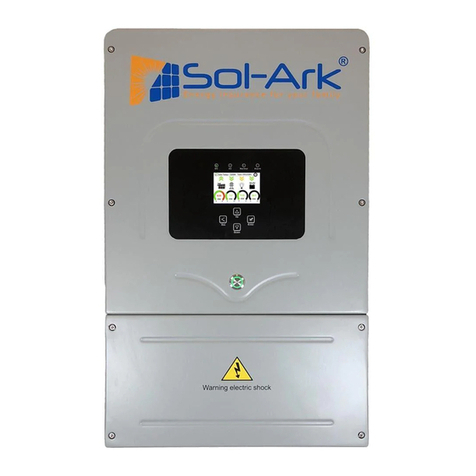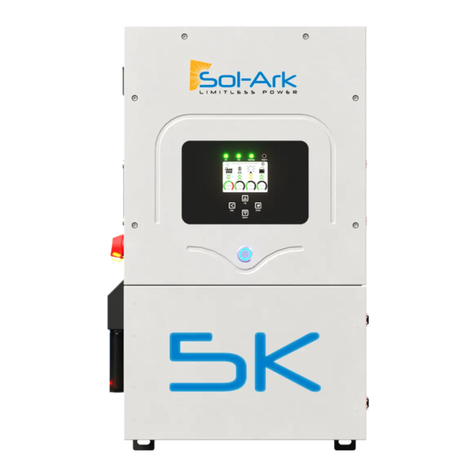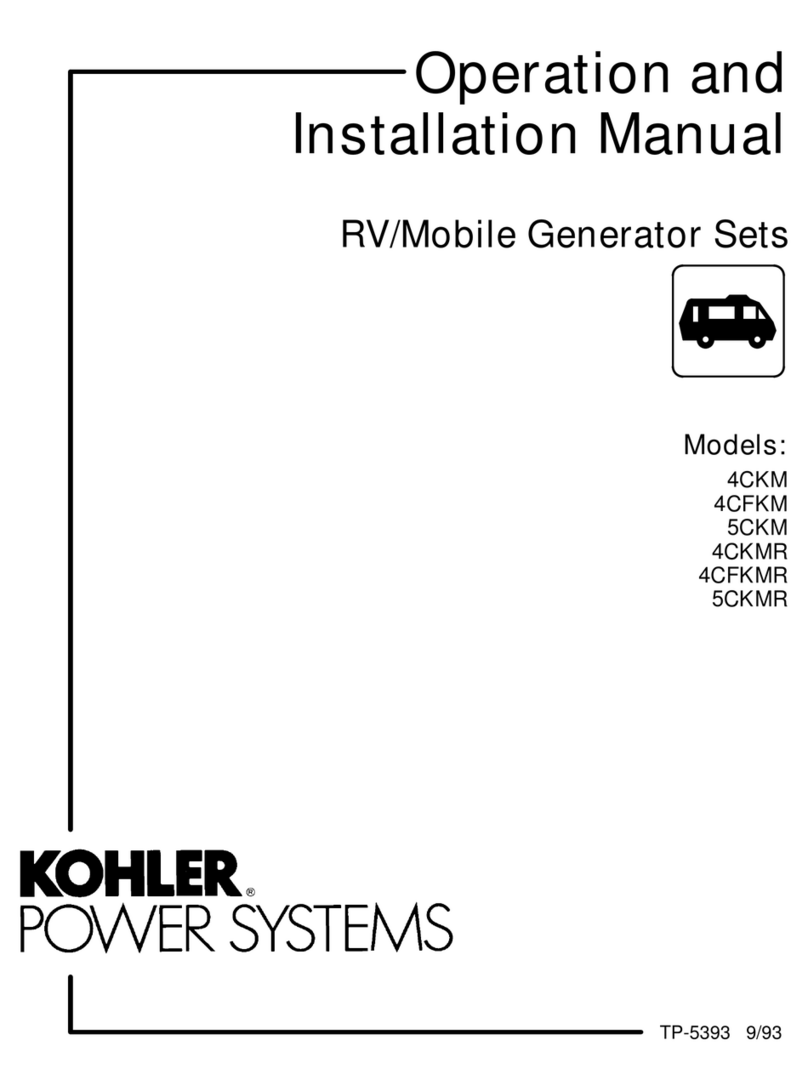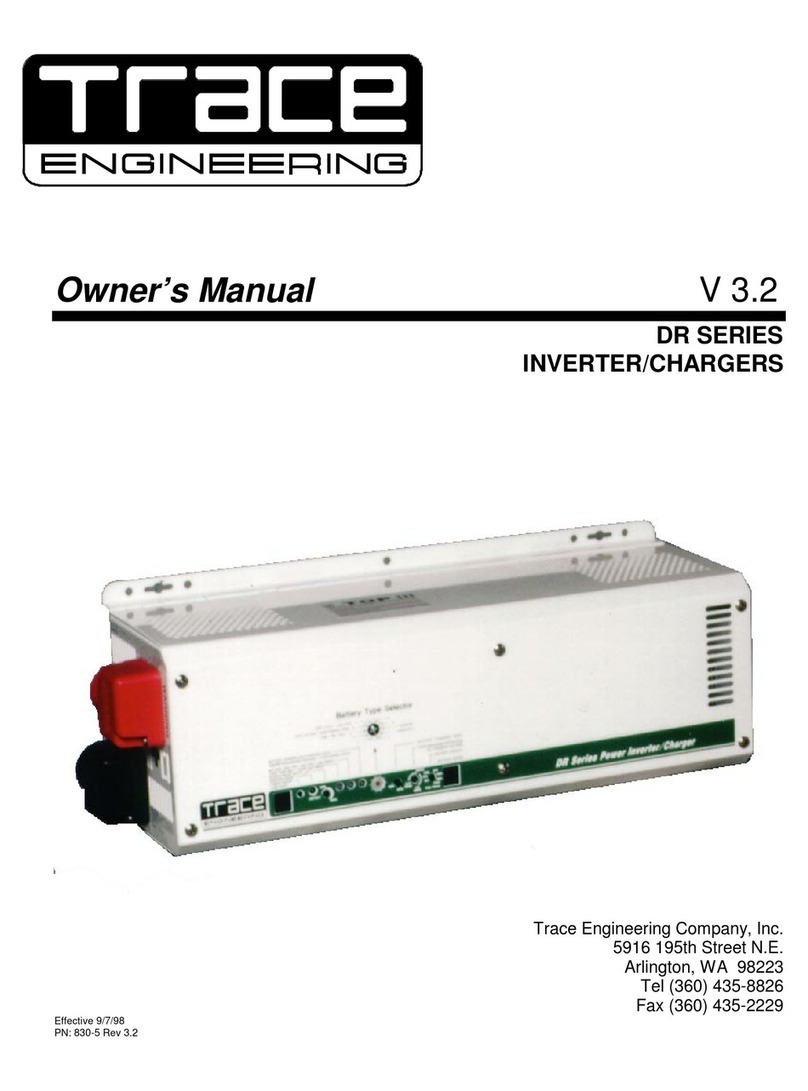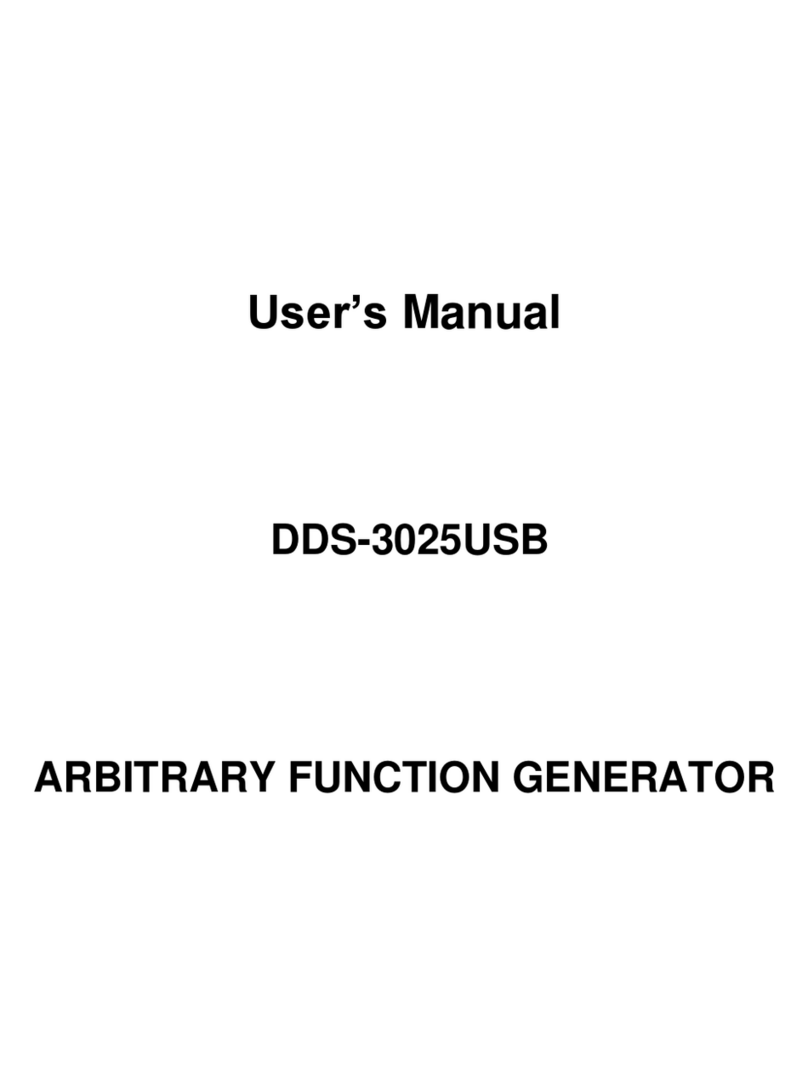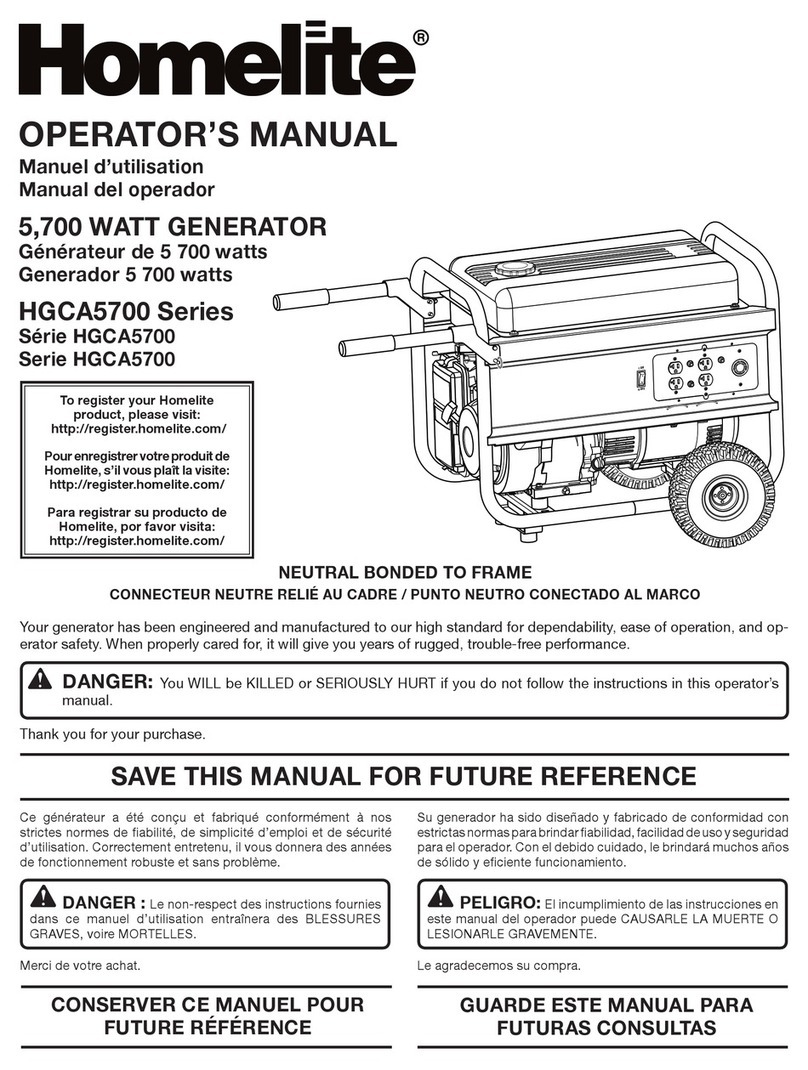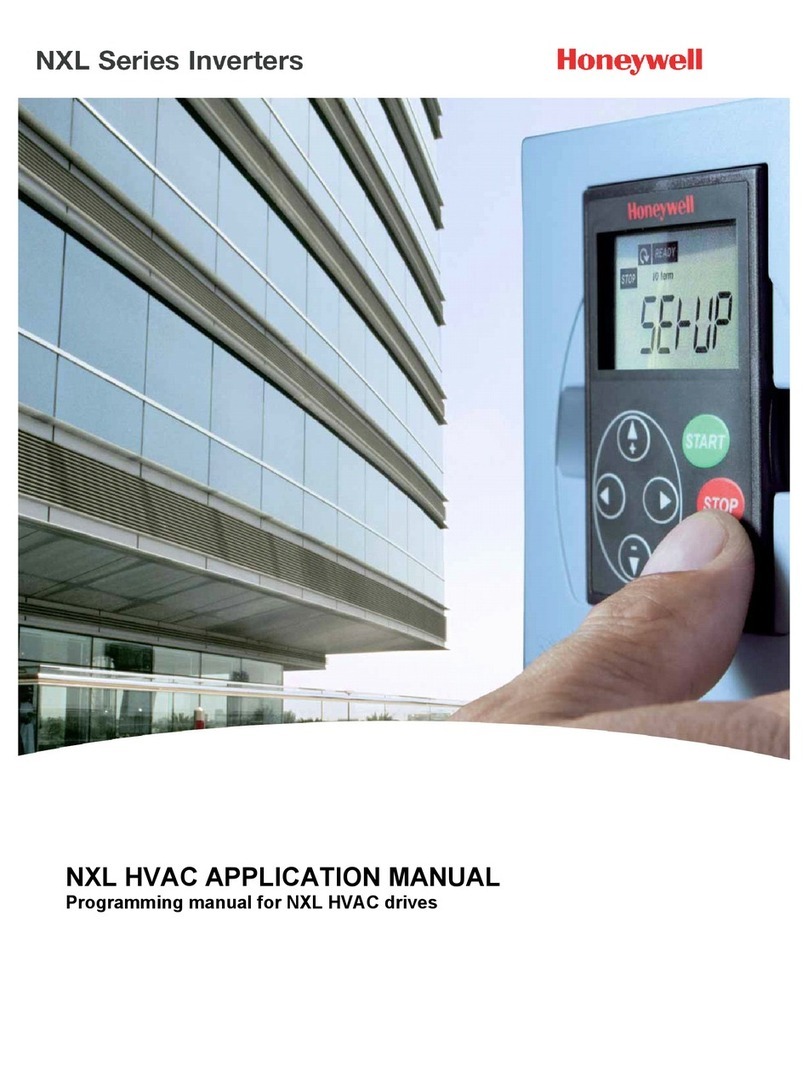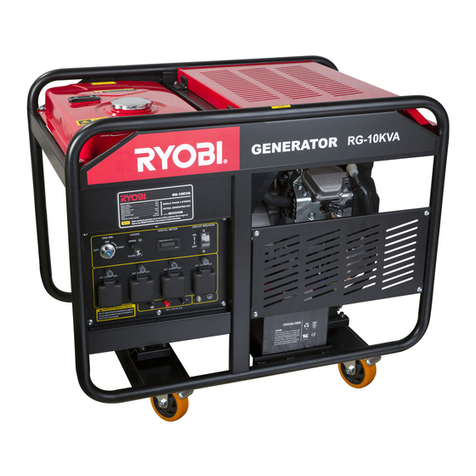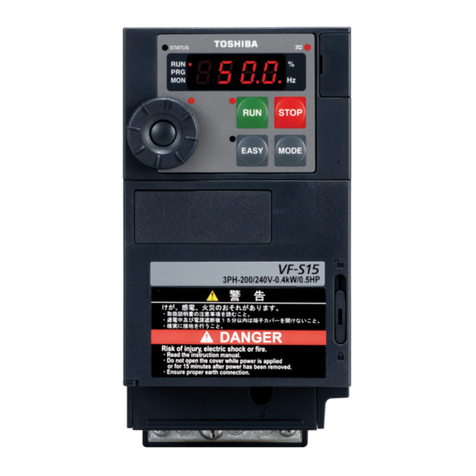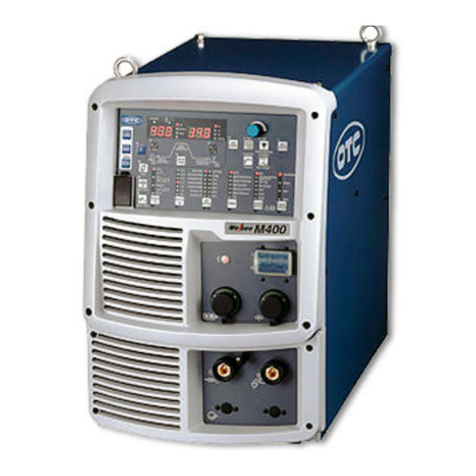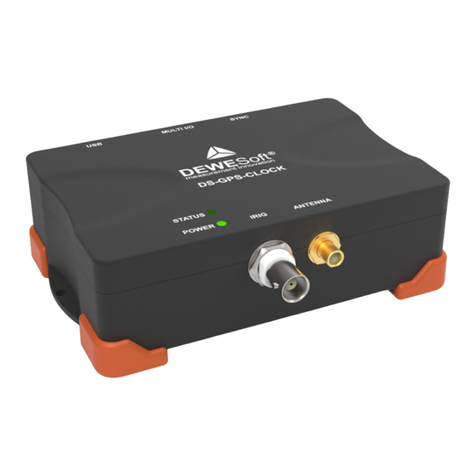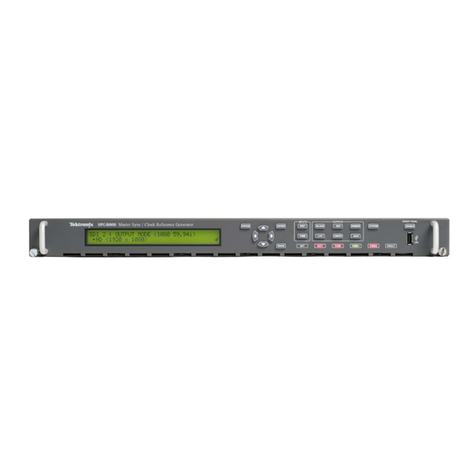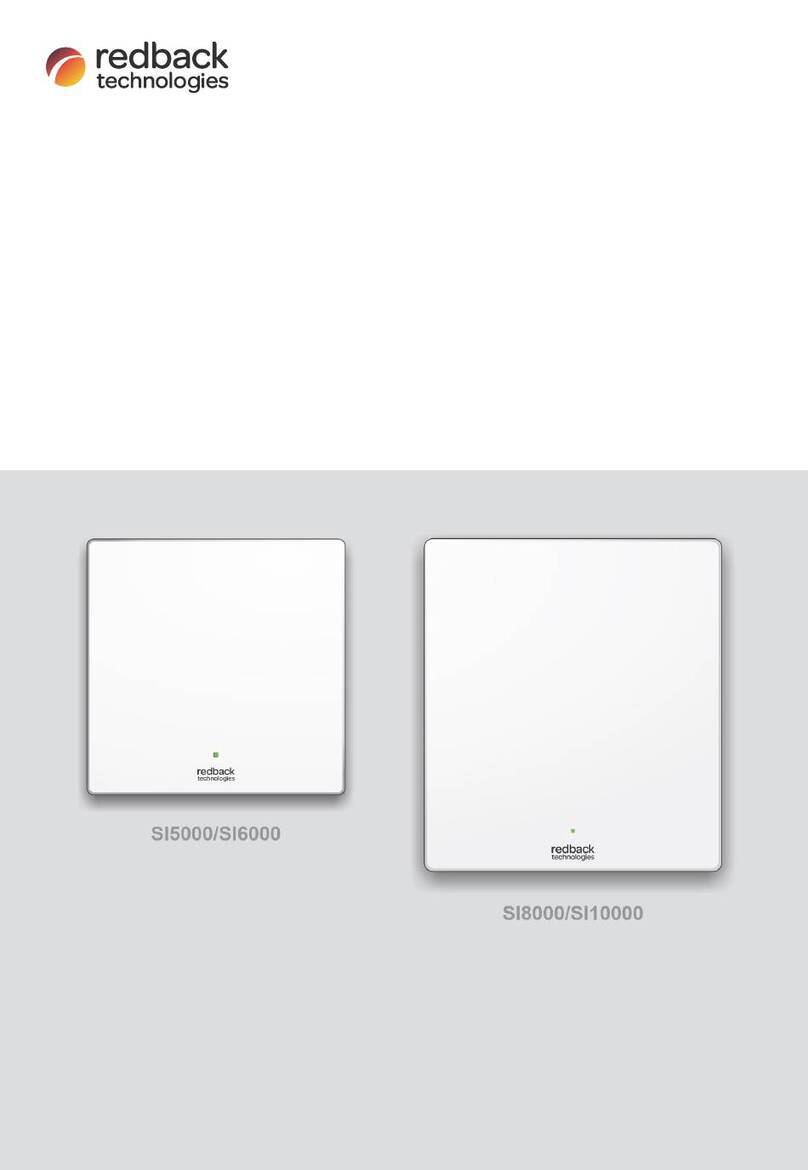Solark 8K-1P-N Assembly instructions

INSTALLATION GUIDE
AND USER MANUAL
RESIDENTIAL
NORTH AMERICA
EN

2 Copyright ©2023 Sol-Ark - Portable Solar LLC | SK140-0009-001

Copyright ©2023 Sol-Ark - Portable Solar LLC | SK140-0009-001 3
READ THE INSTRUCTIONS COMPLETELY BEFORE OPERATING THE EQUIPMENT
Turn on and program the unit only using batteries before connecting the utility grid.
Check the utility voltage before connecting to the unit.
Verify the inviter’s programmed grid type before connecting to the utility.
The unit will be programmed in 120V Single-Phase at 60Hz by default.
Disregarding these instructions could result in permanent damage to the unit
DISCLAIMER
UNLESS SPECIFICALLY AGREED TO IN WRITING:
Sol-Ark assumes no responsibility or liability for any damages, property loss, personal injury, or any adverse consequences resulting from
improper use and installation of the product or the failure to adhere to the guidelines provided in this document. Users are expressly advised
to follow the instructions and guidelines outlined in the documentation accompanying the product. Sol-Ark shall not be liable for any
damages or losses incurred due to deviations from recommended usage, installation, or maintenance procedures. By using the product,
users acknowledge their understanding of these disclaimers and agree to use the product at their own risk. Sol-Ark reserves the right to
update or modify product information, specifications, and guidelines without prior notice.
Sol-Ark retains the right to final interpretation of this document and all related materials pertaining to this product. This document is subject
to modifications, updates, revisions, or termination without prior notice. For the latest product information, please visit Sol-Ark’s official
website. www.sol-ark.com
This manual is only for the 8K-1P-N Hybrid Inverter.
For support, contact:
(USA) +1 (972) 575-8875 ext. (2)
support@sol-ark.com

4 Copyright ©2023 Sol-Ark - Portable Solar LLC | SK140-0009-001
Table of Contents
IMPORTANT SAFETY INSTRUCTIONS........................................................................................................................................................................................................... 5
1. Sol-Ark: At a First Glance..................................................................................................................................6
1.1 General Description ................................................................................................................................................................................................................................... 7
1.2 Specifications .............................................................................................................................................................................................................................................. 8
1.3 Connection Requirements ......................................................................................................................................................................................................................10
2. Installation........................................................................................................................................................ 11
2.1 Mounting the Sol-Ark...............................................................................................................................................................................................................................11
2.2 Integrating Batteries.................................................................................................................................................................................................................................13
2.3 Battery Communication with MODBUS/CANBUS............................................................................................................................................................................... 14
2.4 Ground Connection .................................................................................................................................................................................................................................15
2.5 Connecting PV Modules..........................................................................................................................................................................................................................15
2.6 Integrating a Generator...........................................................................................................................................................................................................................16
2.7 Grid Peak Shaving ....................................................................................................................................................................................................................................17
2.8 Automatic Generator Start ......................................................................................................................................................................................................................17
2.9 Integrating Sensors and Accessories ....................................................................................................................................................................................................18
2.10 Limit Sensors (CT sensors) ....................................................................................................................................................................................................................19
2.11 Powering-up and Testing the Sol-Ark.................................................................................................................................................................................................21
2.12 Power Cycle Sequence..........................................................................................................................................................................................................................21
3. User Interface................................................................................................................................................... 22
3.1 LED Indicators ...........................................................................................................................................................................................................................................22
3.2 Main Menus ...............................................................................................................................................................................................................................................22
3.3 Basic Setup ................................................................................................................................................................................................................................................ 24
3.4 Battery Setup.............................................................................................................................................................................................................................................25
3.5 Limiter.........................................................................................................................................................................................................................................................27
3.6 Grid Setup..................................................................................................................................................................................................................................................31
4. Installation Tips ............................................................................................................................................... 33
4.1 Battery Charge Controller.......................................................................................................................................................................................................................33
4.2 Grid Compliance Settings .......................................................................................................................................................................................................................34
5. Parallel Systems .............................................................................................................................................. 35
5.1 Before Enabling Parallel Operations.....................................................................................................................................................................................................35
5.2 Parallel Systems Programming Sequence............................................................................................................................................................................................ 36
6. Wi-Fi / Ethernet Connection.......................................................................................................................... 37
6.1 Ethernet Connection................................................................................................................................................................................................................................37
6.2 Wi-Fi (PC or Smart Phone).......................................................................................................................................................................................................................37
7. Wiring Diagrams ............................................................................................................................................. 42
8. Troubleshooting Guide.................................................................................................................................. 50
8.1 Sol-Ark Error codes ..................................................................................................................................................................................................................................52
9. Warranty Verification Checklist .................................................................................................................... 53
9.1 Limited Warranty: Sol-Ark 8K-1P-N .......................................................................................................................................................................................................54
10. GUI Screens ................................................................................................................................................ 55

Copyright ©2023 Sol-Ark - Portable Solar LLC | SK140-0009-001 5
IMPORTANT SAFETY INSTRUCTIONS
SYMBOLS THAT APPEAR IN THIS DOCUMENT
WARNING: This symbol indicates information that, if ignored, could cause serious injury, equipment damage, or death.
CAUTION: This symbol indicates information that, if ignored, could result in minor injury or equipment damage.
NOTE: This symbol indicates relevant information that is not related to hazardous situations.
WARNINGS
Read this entire document before installing or using the Sol-Ark 8K-1P-N inverter. Failure to follow any of the instructions or warnings
in this document can result in electrical shock, serious injury, or death. Damage to the 8K-1P-N inverter is also possible, potentially rendering
it inoperable.
High Life Risk due to fire or electrocution –ONLY qualified persons should install the Sol-Ark inverter.
The system must have Ground connections and Neutral connections. Ground MUST be bonded to Neutral ONLY ONCE in the circuit.
Solar PV+/PV- are UNGROUNDED. Note, you may ground PV Racking/Mounts, but doing so directly to the Sol-Ark will likely result in
damage in the case of a direct lightning strike to the PV array.
DO NOT connect the grid to the “LOAD” output terminal.
DO NOT reverse the polarity of batteries. Damage WILL occur.
DO NOT exceed 500Voc on any MPPT on the Sol-Ark.
DO NOT turn off the battery breaker if there is current flowing in or out of the battery in any amount.
DO NOT use impact drivers to tighten any fasteners on the Sol-Ark.
MUST use conduit (or double insulated wire) for AC wires entering/exiting Sol-Ark user area.
ALL terminals/breakers, including battery, MPPT, and AC Terminal Block inputs, should only have one conductor connected to them.
MUST use strain reliefs on ALL wires entering/exiting the Sol-Ark user area.

6 Copyright ©2023 Sol-Ark - Portable Solar LLC | SK140-0009-001
1. Sol-Ark: At a First Glance
INSPECT SHIPMENT
The box should include all items shown in the component guide. If there is damage or missing parts, immediately call the phone number
(USA) +1 (972) 575-8875 Ext. 2.
COMPONENT GUIDE
The Sol-Ark 8K-1P-N system includes the following components:
Component
Description
Quantity
A
Sol-Ark 8K-1P-N inverter
1
B
French cleat
1
C
M8x80mm expanding anchors
4
D
CAT 5E communication cable
1
E
Allen key (2.4 mm)
1
F
Temperature sensor
1
G
User manual
1
H
Wi-Fi / Ethernet antenna (dongle)
1
I
Current transformer (CT sensors)
1
A B C D E
F G H I

Copyright ©2023 Sol-Ark - Portable Solar LLC | SK140-0009-001 7
1.1 General Description
Component
Name
Component
Name
A
ON / OFF Button
H
PV DC disconnect
B
LCD touch screen
I
Wi-Fi / Ethernet dongle
C
Battery terminals
J
BMS RJ45 ports (RS485 / CAN)
D
Parallel RJ45 ports
K
2x MPPT inputs
E
Input pinouts for sensors and accessories
L
(40A) GEN terminal
F
(50A) LOAD supplementary protective device
M
(50A) LOAD terminal
G
Internal AC conductors
N
(50A) GRID terminal
A
B
C
D
E
F
H
I
I
L
M
N
K
J
G

8 Copyright ©2023 Sol-Ark - Portable Solar LLC | SK140-0009-001
1.2 Specifications
SOL-ARK 8K-1P-N TORQUE VALUES APPLICATION NOTE
Do not use impact drivers to tighten any fasteners on the Sol-Ark
Terminal / Breaker
Torque [in-lb]
Torque [Nm]
“GEN”
17 in-lb
2 Nm
“LOAD”
17 in-lb
2 Nm
“GRID”
17 in-lb
2 Nm
Cover Screws
26.5 in-lb
3 Nm
Temperature derating
Optimum: -25°C to 60°C
Derating: >45°C
DC: Shutdown @100°C
AC: Shutdown @82°C

Copyright ©2023 Sol-Ark - Portable Solar LLC | SK140-0009-001 9
D A T A S H E ET
8K-1P-N Lite
Residential Hybrid Inverter
Inverter Model:
5K-120V/8K-230V-1P
SKU:
5K-1P
Input Data (PV)
Max. Allowed PV Power (STC)
10,400W
Rated MPPT Operating Voltage Range
200 - 425V
MPPT Voltage Range
125 - 500V
Startup Voltage
125V
Max. Input Voltage 1
500V
Max. Operating Input Current per MPPT
26A
Max. Short Circuit Current per MPPT
34A
No. of MPP Trackers
2
No. of PV Strings per MPPT
2
Output Data (AC)
Nominal AC Voltage
240V Single-Phase
Real Power, max continuous 2
8,000W
Max. Output Current 3
33.3A
Peak Apparent Power (5s, off-grid) 4
12,000VA
Additional AC Output Voltages (single phase)
120V - 127V –220V –230V
Grid Frequency
50 / 60Hz
Max. Grid Passthrough Current
50A
Power Factor Output Range
+/- 0.9 adjustable
Backup Transfer Time
5ms
Max Efficiency
97.6%
Sell Back Power Modes
Limited to Household / Fully Grid-Tied
Design (DC to AC)
Transformerless DC
Stackable
Up to 8 in parallel
Battery Input Data (DC)
Battery Technologies
Lithium / Lead Acid
Nominal DC Voltage
48V
Operating Voltage Range
40 - 60V
Capacity
50 —9900Ah
Max. Battery Charge / Discharge Current
120A
Charging Controller
3-Stage with Equalization
Grid to Battery Charging Efficiency
96.0%
External Battery Temperature Sensor (BTS)
Included
Automatic Generator Start (AGS)
2 Wire Start - Integrated
BMS Communication
CANBus & RS485 MODBUS
General Data
Dimensions (H x W x D)
600 x 330 x 237 mm ( 23.6 x 13 x 9.3 in)
Weight
24 kg / 53 lb.
Enclosure
IP65 / NEMA 3R
Ambient Temperature
-40~60°C, > 45°C Derating
Noise
< 30 dB @ 25°C (77°F)
Idle consumption - No Load
60W
Communication and Monitoring
Wi-Fi & LAN Hardware Included
Standard Warranty
10 Years
Protection and Certifications
Certifications and Listings
UL1741-2010/2018, IEEE1547a-2003/2014
PV Arc Fault Detection —NEC 690.11
Integrated
PV Input Lightning Protection
Integrated
Anti-Islanding Protection
Integrated
PV String Input Reverse Polarity Detection
Integrated
Insulation Resistor Detection
Integrated
Residual Current Monitoring Unit
Integrated
Output Over Current Protection
Integrated
Output Shorted Protection
Integrated
Surge Protection
DC Type II / AC Type II
1. See Installation Guide for more details on sizing array strings. The highest input voltage is based on the open-circuit voltage of the array at the minimum design temperature.
2. Maximum continuous power will vary depending on programmed output voltage: 8,000W @ 220V, 230V & 240V and 4,800W @ 120 & 127V.
3. Maximum output current will vary depending on programmed output voltage.
4. Peak power will vary depending on programmed output voltage: 12,000VA @ 220V, 230V & 240V and 7,200W @ 120 & 127V.

10 Copyright ©2023 Sol-Ark - Portable Solar LLC | SK140-0009-001
1.3 Connection Requirements
1. AC / DC Connection Requirements
All wire runs should be sized to be at or below a 2.5% voltage drop at full load. Wire size must comply with your local electrical code.
Port
Terminal / Breaker Rating
Terminal Wire Size Range (min-max)
GRID
50A AC
8 –6 AWG
LOAD
50A AC
8 –6 AWG
GEN
40A AC
8 –6 AWG
MPPT
34A ISC
12 –10 AWG
Battery Port
120A DC
2 –2/0 AWG
2. Sensors and Communications Requirements
Component
Wire Size Range
Max Distance
CT Sensor
16-20 AWG
0’ – 13’ [4 m]: 16 AWG included
13’ – 20’ [6 m]: CAT6 extendable
Communications
24 –23 AWG
0’ – 100’ [30 m]: 24 AWG
100’ – 400’ [120 m]: 23 AWG
RJ45 Parallel Communication
CAT 5E or better
0’ – 7’ [2.1 m]: Included
7’ – 20’ [6m]: Extendable
Batteries
AC Conductors
PV Conductors
Sensors
CT Sensor (Included)
AC Breaker (Single pole)
1 in [25.4 mm]
6 AWG max
5/16 in
[8 mm]
1/4 in
[6.35 mm]
10 AWG max
20 AWG max
2/0 AWG max
5/8 in
[16 mm] 5/8 in
[16 mm]
5/8 in
[16 mm]
13 ft
[4 m]

Copyright ©2023 Sol-Ark - Portable Solar LLC | SK140-0009-001 11
2. Installation
Backup Circuits
A. The “LOAD” connected service panel will be referred to as the Essential Loads Panel.
B. You must keep the essential loads panel within the limitations of the unit:
•Grid Tie 12 kW = 240V * 50A max (passthrough).
•Off-Grid 8 kW = 240V * 33.3A continuous (batteries or PV).
C. Verify that every load circuit power (P=V*I) does not surpass the aforementioned limits.
Single System Install
A. FOR PARTIAL BACKUP: Connect the output of your back-feed breaker or line side tap (depending on the point of interconnection)
to the "GRID" terminal.
•An external disconnect must be installed between the interconnection and the Sol-Ark. Size the disconnect according to code.
•Connect the "LOAD" output to the Essential Loads Panel. Follow electric code to select proper wire gauge.
B. FOR WHOLE-HOME BACKUP: Connect the incoming grid directly to the “GRID” input terminal.
•An external disconnect must be installed between the grid and the Sol-Ark. Size the disconnect according to code.
•Connect the “LOAD” output to the Main Service Panel. Follow electric code to select proper wire gauge.
It is possible to connect a generator or an AC coupled source (30A max or 7,200W) such as string or micro inverters to the “GEN” terminal
of the inverter. Only one AC source can be connected to the “GEN” terminal at a time.
An external battery breaker is required. External breakers must be sized according to local AHJ.
Grid Tied Battery Export Only
2.1 Mounting the Sol-Ark
A. Considering the dimensions of the inverter, find a suitable location for the system. There must be at least 6 in [15 cm] of vertical
clearance and 2 in [5 cm] of side clearance for proper heat dissipation.
Max heat dissipation of 192W
AC
DC
PV
Battery
Grid
Main Panel
Subpanel
≥ 6” [15 cm]
≥ 6”[15 cm]
≥ 2” min [5 cm]
6” if next to
another system
≥ 2” min [5 cm]
6” if next to
another system
≥ 20” [50 cm]
≥ 6” [15 cm]
≥ 6”[15 cm]

12 Copyright ©2023 Sol-Ark - Portable Solar LLC | SK140-0009-001
B. Under certain conditions, the National Electrical Code® specifies greater clearances. Ensure that the prescribed clearances in
accordance with the National Electrical Code®, paragraph 110.26 and Canadian Electrical Code® CSA C22.1 are adhered to.
C. The Sol-Ark 8K-1P-N is a NEMA 3R - IP65 enclosure that is rated for outdoor installation but can also be installed indoors.
D. PROTECT THE LCD SCREEN from direct exposure to UV light.
E. Use screws or anchors suitable for the support surface and capable of supporting the weight of the inverter (53 lb / 24kg).
a. For Concrete or Masonry Mounting: Use a minimum of four (4) M8x80mm expanding anchors (included).
b. For Wood Frame Mounting: Use a minimum of four (4) 1/4in lag screws with flat washers, making sure to anchor into at
least 2 framing members. (not included)
c. For Metal Framing Mounting: Use a minimum of four (4) 1/4in self-tapping metal screws with flat washers. (not included)
F. In the case a different anchorage is required, calculate the support needed to properly hold the weight of the equipment
Damage to the LCD Screen due to direct sunlight exposure will not be covered by warranty
G. Mount the inverter in the optimal orientation as shown below.
Suitable anchor for
the wall surface

Copyright ©2023 Sol-Ark - Portable Solar LLC | SK140-0009-001 13
2.2 Integrating Batteries
A. Sol-Ark 8K-1P-N must be OFF while the batteries are being connected.
B. Depending on the battery voltage, wire up the battery bank in the possible configurations shown below.
C. Battery breakers must be OFF when wiring. If your battery bank does not have internal breakers, maintain the necessary safety
measures when handling.
Sol-Ark 8K-1P-N is a 48VDC nominal system. DO NOT connect the inverter to any other battery configuration. If you use 12V batteries,
you MUST NOT exceed four (4) batteries in series, as shown. The inverter can work with any battery chemistry as long as it remains within
the range of 40VDC to 60VDC.
48V batteries in parallel connection
12V batteries in series connection
Series and parallel connections for complete 48V batt bank
DO NOT
reverse polarity. The system will be damaged, and warranty will be
voided!
IMPORTANT NOTE: Multi-system install
A. ALL parallel inverters MUST connect to a single battery bank. The system will NOT operate properly if this instruction is not followed.
B. DO NOT use separate battery banks in parallel systems.

14 Copyright ©2023 Sol-Ark - Portable Solar LLC | SK140-0009-001
Follow all battery manufacturer-specified values to ensure proper charging and discharging
BATTERY CHARGING SETPOINT EXAMPLES (48V NOMINAL)
Battery Type
Absorption
Float
Equalize (Every 30 days for 3hr)
AGM / PCC
57.6V
53.6V
57.6V
Gel
56.4V
54.0V
Wet
59.0V
55.0V
59.0V
Lithium
54.6V
54.3V
-
CALCULATING BATTERY BANK AMP-HOURS EXAMPLES (AGM)
# of batteries
Voltage per Battery
Ah per battery
Ah @48V
(Chain of 4 batteries of 12V in series)
Max Charge / Discharge (A)
4
12V
230Ah
230Ah
100A
8
12V
230Ah
460Ah
120A
12
12V
230Ah
690Ah
120A
2.3 Battery Communication with MODBUS/CANBUS
RJ-45 Configurations
The Sol-Ark 8K-1P-N inverter achieves battery communications through a single RJ-45 port labeled “Battery CANBus”. This port combines
the RS-485 and CANBus pin configurations shown below. Both “Modbus RS485” and “Battery CANBus” ports are capable of Modbus
communication.
Complete battery integration guide of supported battery communications can be found at: sol-ark.com/battery-partners
Any damage caused by the improper use of the communication protocols (CANBUS or MODBUS) will not be covered by warranty.
Modbus map is available upon request for “READ” operations only. Contact technical support to obtain the MODBUS map.
External MODBUS Devices
If an external device utilizes BMS Lithium Batt 00, one must change the Modbus SN of the inverter to 01 as the default value is 00.
Pin
RS485
Battery CANBus
1
RS-485 B-
--
2
RS-485 A+
--
3
--
--
4
--
CAN Hi
5
--
CAN Lo
6
GND
GND
7
RS485 A+
--
8
RS485 B-
--
1 2 3 4 5 6 7 8
RJ-45 port configuration

Copyright ©2023 Sol-Ark - Portable Solar LLC | SK140-0009-001 15
2.4 Ground Connection
It is essential to add a grounding connection directly into the frame with the goal of protecting the end user in case of experiencing a failure
on the original ground conductor.
When the system is installed for an Off-Grid application, the neutral must be connected to ground
2.5 Connecting PV Modules
The Sol-Ark 8K-1P-N has 2 independent MPPTs that support up to 2 PV strings each. MPPTs can handle a maximum
VOC of 500V
and an
ISC
of 34A
but will self-limit and operate at
26A
max.
A. Max DC solar input = 10.4 kW (± 5%) | Max input power per MPPT = 5.2 kW | Max recommended input voltage per MPPT = 425 VOC
| Max input current per MPPT = 20A (self-limiting).
B. Design for a max input current of 26A per MPPT. The inverter will self-limit beyond 26A. If ISC exceeds 34A, damage will occur.
C. PV Source Circuit max voltage of 500VDC; damage can occur with PV strings whose open-circuit voltage exceeds 500VDC
D. Strings in parallel on the same MPPT must have the same designed open-circuit voltage (Voc), otherwise the system will be
limited to the lowest string voltage.
i. PV1 A/B must have the same Voc.
ii. If the solar panels are oriented in different directions and connected in the same MPPT, there will be a loss in PV efficiency.
E. Grounding the PV mounting frame directly to the Sol-Ark inverter is not ideal. Additional grounding of the PV system is highly
recommended. The external auxiliary grounding conductor must be sized according to code and must follow all code requirements.
F. Connect the solar panel strings using either of the following configurations:
“Y” connection
Individual strings
AC Coupling
The Sol-Ark 8K-1P-N is a system that supports the addition of AC coupled solar panels. The max solar input power can be expanded by
coupling micro or string inverters into the “GEN” or “LOAD” breakers. A full AC coupled solar system is not recommended as power control
and monitoring is limited. Having DC coupled modules or a combination of DC coupled and AC coupled solar panels is always preferred.
String PV1B
String PV1A
String PV1B
Y
Connector
Y
Connector
String PV1A

16 Copyright ©2023 Sol-Ark - Portable Solar LLC | SK140-0009-001
AC coupled inverters need to be either UL 1741SA or UL 1741 certified. This certification confirms the inverters’ ability to disconnect from
the grid based on frequency and ensures that the Sol-Ark will safely be able to frequency shift to control the AC coupled production.
Batteries are REQUIRED to AC couple solar panels to the “GEN” breaker. The AC coupled inverters can still produce solar power even
during grid outage events or in Off-Grid systems. Furthermore, the total AC coupling production will be monitored.
1. AC coupling on “GEN”
2. AC coupling on “LOAD”
-CAN produce solar power during grid outages.
-CAN produce solar power for Off-Grid systems.
-CAN monitor solar production.
-CAN produce solar power during grid outages.
-CAN produce solar power for Off-Grid systems.
-CANNOT monitor solar production.
-“GEN” input CANNOT be used.
-Backup Transfer Time is extended to 2 seconds.
In Off-Grid systems, Sol-Ark uses
Frequency Shift
technology to shut down AC coupled solutions when the battery is full. Grid-Tied AC coupled
solutions will
always
sell excess solar power back to the grid. “Limited to Load” will
NOT
limit production when AC coupled.
2.6 Integrating a Generator
Generators Smaller than 7.2kW On “GEN”Input
1. ONLY supports 120 and 240V Single-Phase generators. External breaker must be installed.
2. 40A rated “GEN” terminal. 30A continuous.
3. A THD (Total Harmonic Distortion) of less than 15% is preferred.
Generators Greater than 7.2kW On “GRID” Input
1. ONLY supports 120 and 240V Single-Phase connections. The correct grid type must be selected before connecting the generator.
2. Programming “GEN Connect to Grid Input” is required: →Limiter →Other →
🗹GEN Connect to Grid Input
.
3. DO NOT use “Grid Sell” in Off-Grid systems. Potential to damage the generator. Installation of CT sensors on generator lines is
only required if “Peak Shaving” is intended to be used.
Weekly Gen Exercise:
If a generator has two-wire start compatibility, it will experience weekly generator tests. This test occurs at 8:00AM (local
time) every Monday by default. The test takes 20 minutes to complete. The generator will start and stop automatically. The test can be disabled
by specifying :00 | 00 min in the "Generator Exercise Cycle Day & Time" option.
Improve the Generator & Sol-Ark Compatibility
Navigate through the menus and program the following settings to improve the Sol-Ark and generator compatibility and operating range
to avoid frequent disconnections.
1. Change the grid mode to General Standard: →Grid Setup →Grid Selection →Grid Mode.
a. Tap and use the navigation arrows to cycle through the different grid modes. Choose “General Standard”.
2. Increase the frequency range of operation: →Grid Setup →Connect →Reconnect
a. Increase “Grid Hz High” to 65Hz.
b. Decrease “Grid Hz Low” to 55Hz.
c. Replicate changes for the “Normal Connect” settings.
3. Increase the voltage range of operation:
a. Increase “Grid Volt High” to 275V.
b. Decrease “Grid Volt Low” to 185V.
c. Replicate changes for the “Normal Connect” settings.
Sol-Ark will not charge the batteries using the generator unless the “Start V” or “Start %” condition is fulfilled. Only one condition (V or %) can
be modified at a time depending on the control mode selected (“Use Batt V Charged” or “Use Batt % Charged”)

Copyright ©2023 Sol-Ark - Portable Solar LLC | SK140-0009-001 17
2.7 Grid Peak Shaving
1. To use Peak-Shaving on a generator, the equipment MUST be connected to the “GRID” terminal of the inverter.
2. Peak-Shaving helps reduce grid consumption during peak demand by utilizing battery backup power. It can also be used to prevent
generator overload above a specified power threshold.
3. Install the CT sensor on grid / generator line. The arrow on the CT MUST point toward the grid / generator.
4. The Sol-Ark supplies power from the batteries whenever the “Power” threshold is met.
5. This mode will automatically adjust the “Grid Charge” amperage (A) to avoid generator overloads during battery charging.
6. Grid Peak-Shaving will automatically enable “Time of Use” and MUST be configured.
2.8 Automatic Generator Start
1. “🗹Gen Charge” is used when the generator is connected to the “GEN” terminal.
a. “Start V” or “Start %” is the set-point/condition that must be fulfilled to automatically start the generator.
b. To charge from the “GEN” source, “🗹Gen Charge” must be enabled.
c. Batteries will charge from a generator until the battery bank accepts 5% of its programmed capacity in Amperes (A).
This is equivalent to around 95% of the state of charge (SOC).
2. “🗹Grid Charge” is used to charge the battery from the “GRID” source (grid or a generator).
a. “Start V” or “Start %” is the set-point/condition that must be fulfilled to start the battery charge from the “GRID” source.
This will auto-start a generator as well.
b. To charge the battery from the “GRID” source, “🗹Grid Charge” must be selected: →Battery Setup →Charge.
c. From utility grid: the batteries will be charged to 100% SOC.
d. From generator: the batteries will charge until the battery bank accepts 5% of its rated capacity in Amperes (A). This is
equivalent to around 95% SOC.
If
“Time of Use”
(TOU) is enabled, a time to charge from that GRID or GEN source
MUST
be designated.
“🗹Charge”
must be checked on
desired time intervals, otherwise the generator will not start automatically even if the Start V or Start % condition has been met.
Gen Charge / Grid Charge “A”
“A” is how many amps (DC) are supplied to the battery from a generator. Adjusting and limiting the GEN or GRID “A” value will ensure that
small generators are not overloaded when charging the battery bank.
Grid peak-shaving settings
Generator and grid charge settings

18 Copyright ©2023 Sol-Ark - Portable Solar LLC | SK140-0009-001
2.9 Integrating Sensors and Accessories
Inverter pinouts for sensors and accessories
•(1,2) Battery temperature sensor: Not polarity sensitive. Used for voltage compensation for Lead Acid batteries
•(+3, -4) CT1: Current transformer (CT) input
•(5,6) Gen Start Relay: Normally open relay for generator two-wire start ( 12V, 100mA max)
•(7,8): Not in use
1. Temperature Sensor
•Place the sensor between two batteries as shown in the next figure.
•Secure with tape and place away from the batteries terminals to prevent overheating.
•This sensor has no polarity. The temperature sensor helps perform voltage charging
adjustments and capacity calculations due to changes in temperature.
•Lithium Batteries DO NOT require our external temperature sensor.
2. Wi-Fi / Ethernet Antenna (Dongle)
•Remote monitoring and software updates require an internet connection through the WI-FI / Ethernet Antenna (Dongle).
•Compatible with Wi-Fi or Ethernet connections.
3. BMS Port (CAN/RS485)
•This port is used to setup a Lithium Battery in closed-loop communication with the Sol-Ark 8K-
1P-N (consult our “Battery Communications Integration Guide” on the Sol-Ark website at
www.sol-ark.com/battery-partners).
•Must use an RJ45 connector.
•Only use the CAN port for battery BMS communications (the CAN port supports both CANBus
protocol and Modbus protocols).
4. GEN Start Signal (Two-wire start)
•Gen start relay: pins 5 & 6.
•The signal comes from a normally open relay that closes when the generator “Start” condition is met
Temperature sensor
Wi-Fi dongle (antenna)

Copyright ©2023 Sol-Ark - Portable Solar LLC | SK140-0009-001 19
2.10 Limit Sensors (CT sensors)
The CT sensors (or limit sensors) enable the use and smooth operation of the system work modes known as “Limited Power to Home” and
“Grid Peak-Shaving”. The CTs will measure and calculate the demand in the Main Service Panel which the Sol-Ark 8K-1P-N will then use to
accurately supply and offset all home loads.
Off-Grid system do not require CT sensors unless “Grid Peak-Shaving” is used
1. CT Sensors Installation
•Install sensors on incoming electrical service wires (L1).
•Embossed arrow on the sensor must point toward the grid.
•To ensure proper fit, check incoming wire diameters (grid or generator). If the sensors are too small, bigger CTs can be purchased
•“Limited Power to Home” (Meter Zero) and “Grid Peak-Shaving” require CT sensors.
•See section 3.5 “Limiter” for more information about the different Sol-Ark work modes.
•See section 7 “Wiring Diagrams” for detailed CT installation.
Back-feed breaker
Line side tap
2. CT Sensor Size
•Sol-Ark includes one 5/8” CT sensor (100A for 2/0 AWG wire gauge).
•Sol-Ark offers 0.94” CTs (200A for 4/0 AWG wire gauge) and 2” CTs (400A) upon request.
•Default Sol-Ark CT ratio is 2000:1
Unless authorized,
DO NOT
change CT Ratio or warranty will be voided
Wire gauge is the only metric used to determine size of CTs. Contact sales at +1 (972) 575-8875 ex.1 to purchase bigger CT sensors
Meter
CT
Main Panel
Meter
CT
Main Panel

20 Copyright ©2023 Sol-Ark - Portable Solar LLC | SK140-0009-001
3. Wiring the CT sensor
•Connect CT1 of line L1 to pins 3 (white) & 4 (black).
•Keep the wires twisted (white-black) throughout the connection.
•If the wires need to be extended, use CAT 6 (shielded) cable to make an extension.
CT Sensors for Parallel Systems
•Each inverter will include one (1) CT sensor.
•Only one CT sensor must be wired to the designated “Master” inverter.
•CT sensors are essential for multi-Sol-Ark systems as “Limited Power to Home” mode is highly recommended.
4. Automatic CT Limit Sensors Configuration
This function REQUIRES batteries and to auto detect and auto correct CT orientation. AC coupled inverters
need to be OFF during the detection test. If this test is done with connected AC-coupled systems, a factory
reset of the Sol-Ark must be performed. Install the CT sensor as described in section 2.10 “Limit Sensor”. A
battery connection and grid power are required before starting the automatic configuration.
→Basic Setup →Advanced →
🗹
Auto detect Home Limit Sensors
Wait at least 10 to 15 seconds while the inverter performs the test. The inverter will alternate the current
distribution in all lines, determining the correct orientation of the sensor.
•On “Limited power to Home” mode (no Grid Sell), HM values will read close to zero (0). Keep in
mind that all sensors have a 3% error.
•To avoid selling power to the utility use “Zero Export Power” equal to or greater than 20W.
•Buying power from the grid will display positive (+) HM values, while selling to the grid displays
negative (-) HM values.
+ -
CT wire extensions with shielded CAT 6
cable
Table of contents
Other Solark Inverter manuals
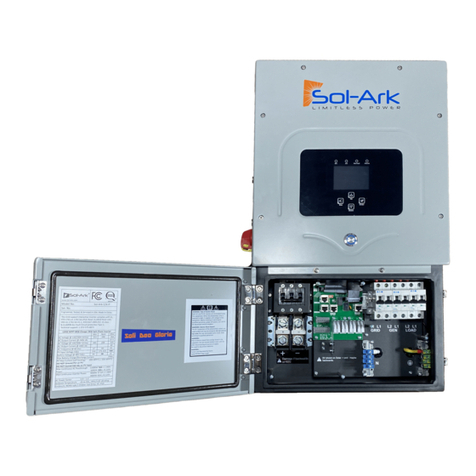
Solark
Solark 12K User manual
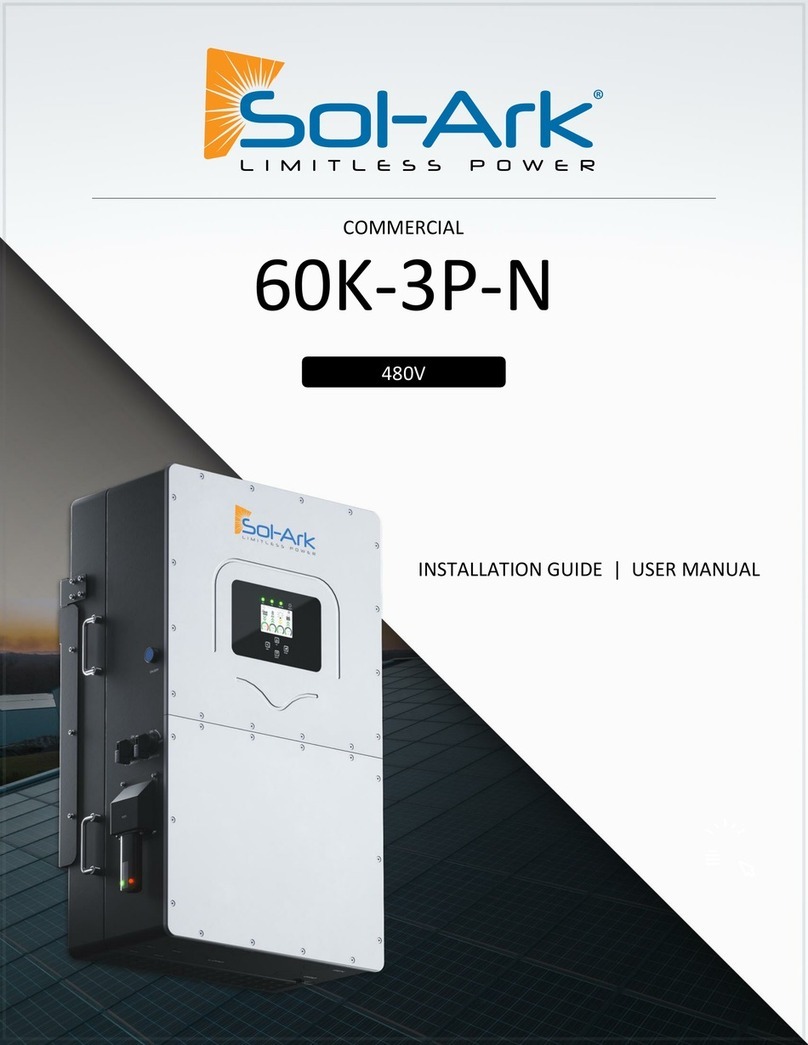
Solark
Solark 60K-3P-N User manual
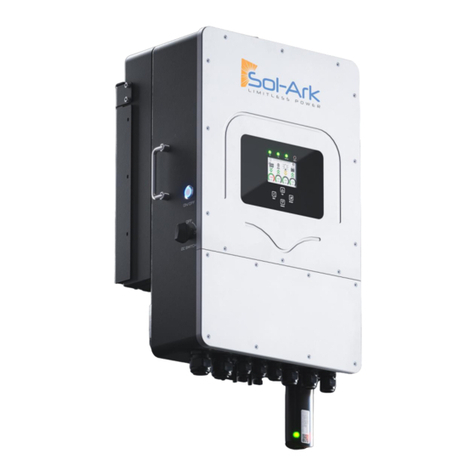
Solark
Solark LATAM 12K-3P-L Troubleshooting guide
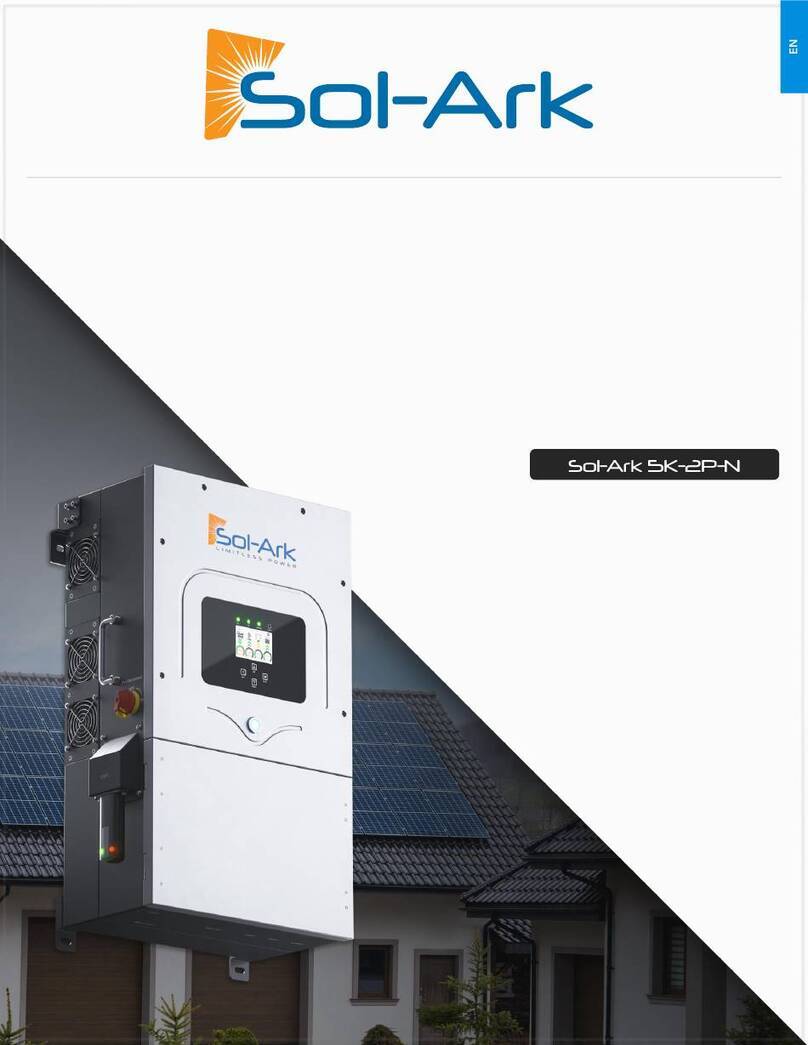
Solark
Solark 5K-2P-N Assembly instructions

Solark
Solark 12K User manual
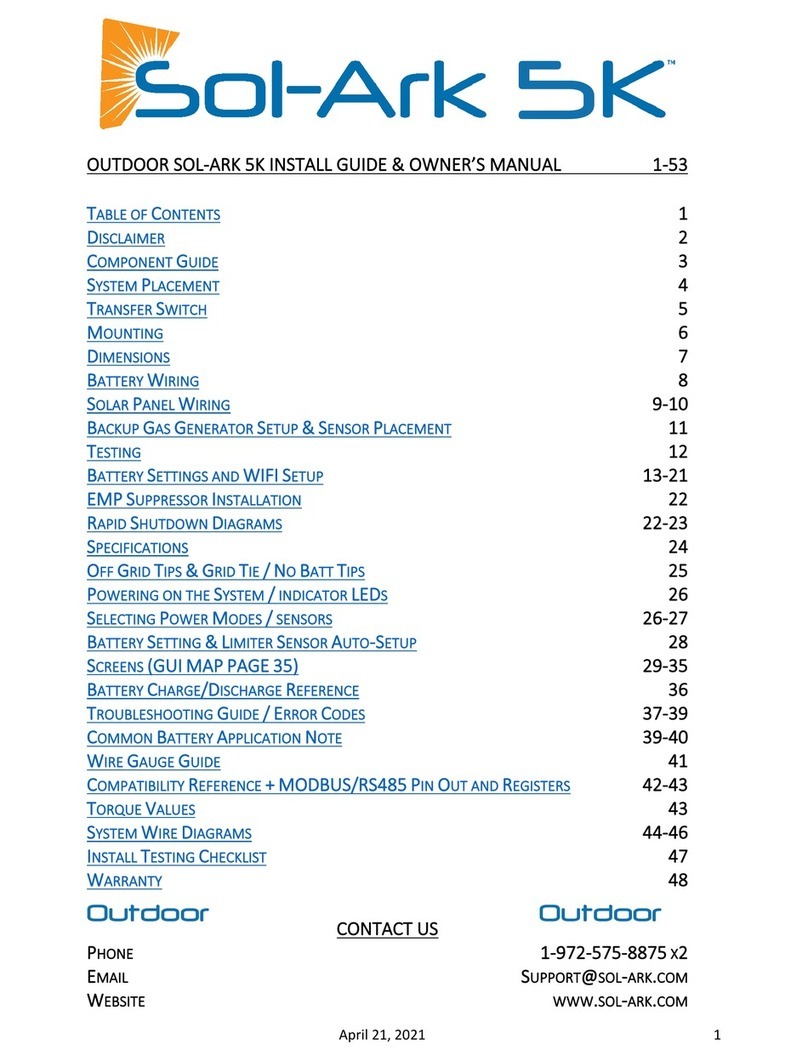
Solark
Solark 5K User manual
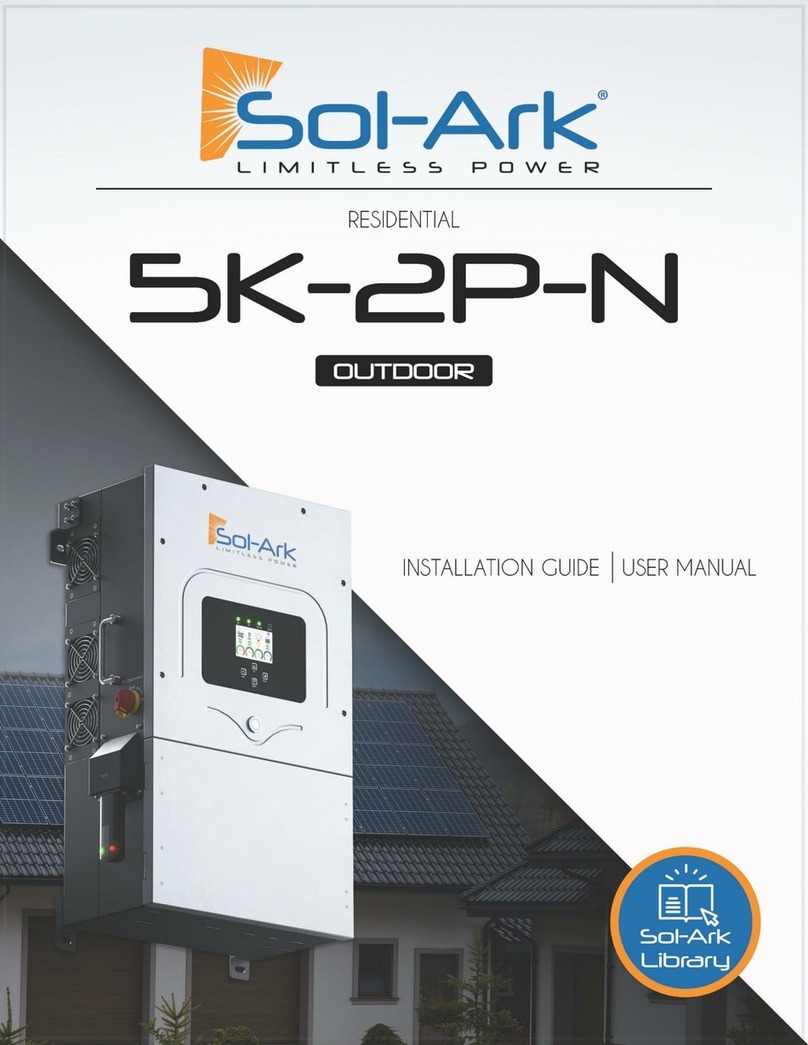
Solark
Solark 5K-2P-N User manual
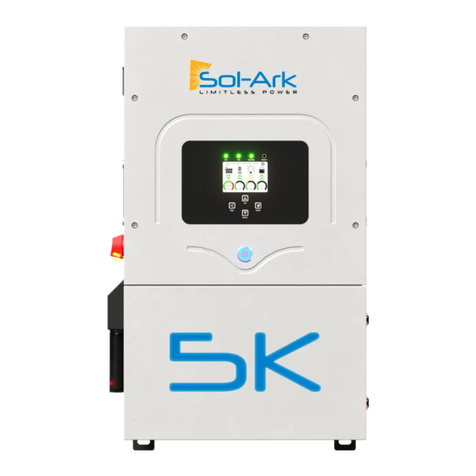
Solark
Solark 5K User manual
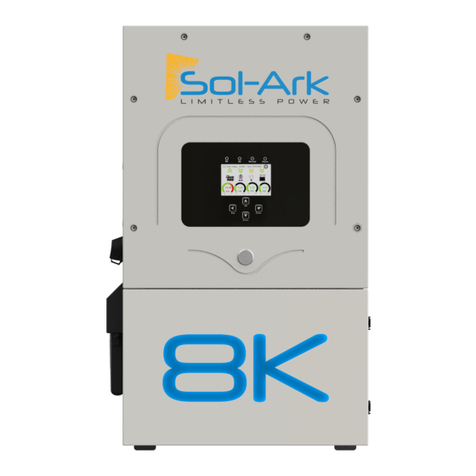
Solark
Solark 8K User manual
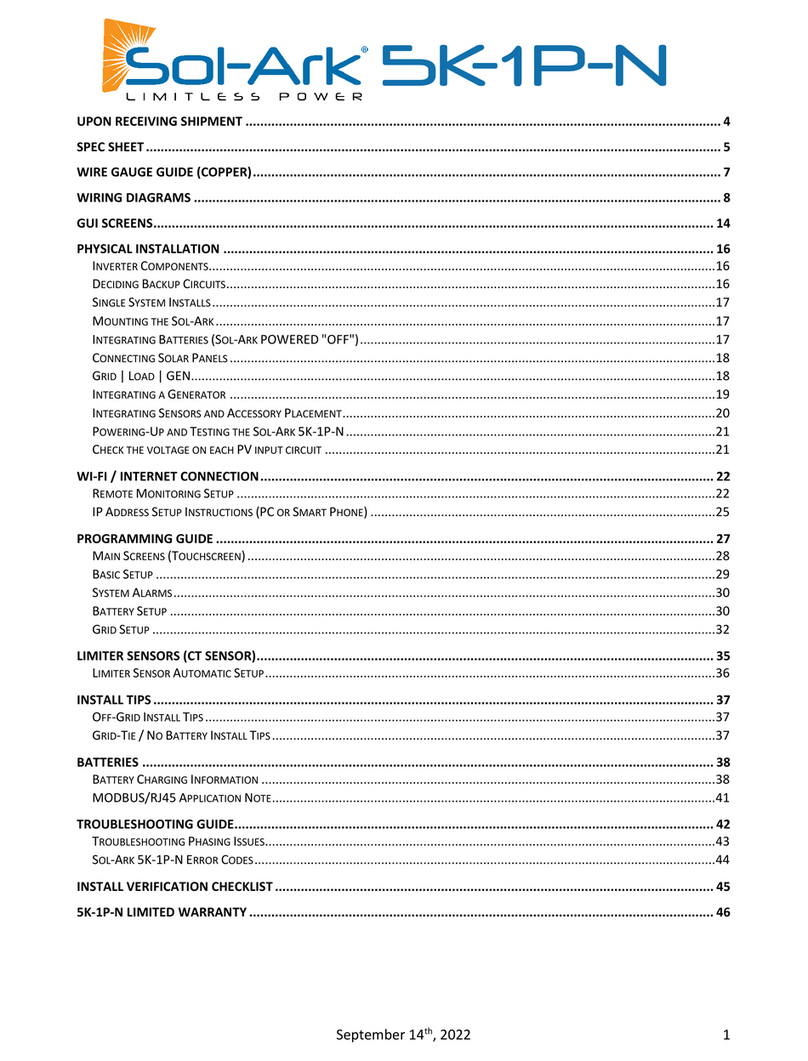
Solark
Solark 5K-1P-N User manual
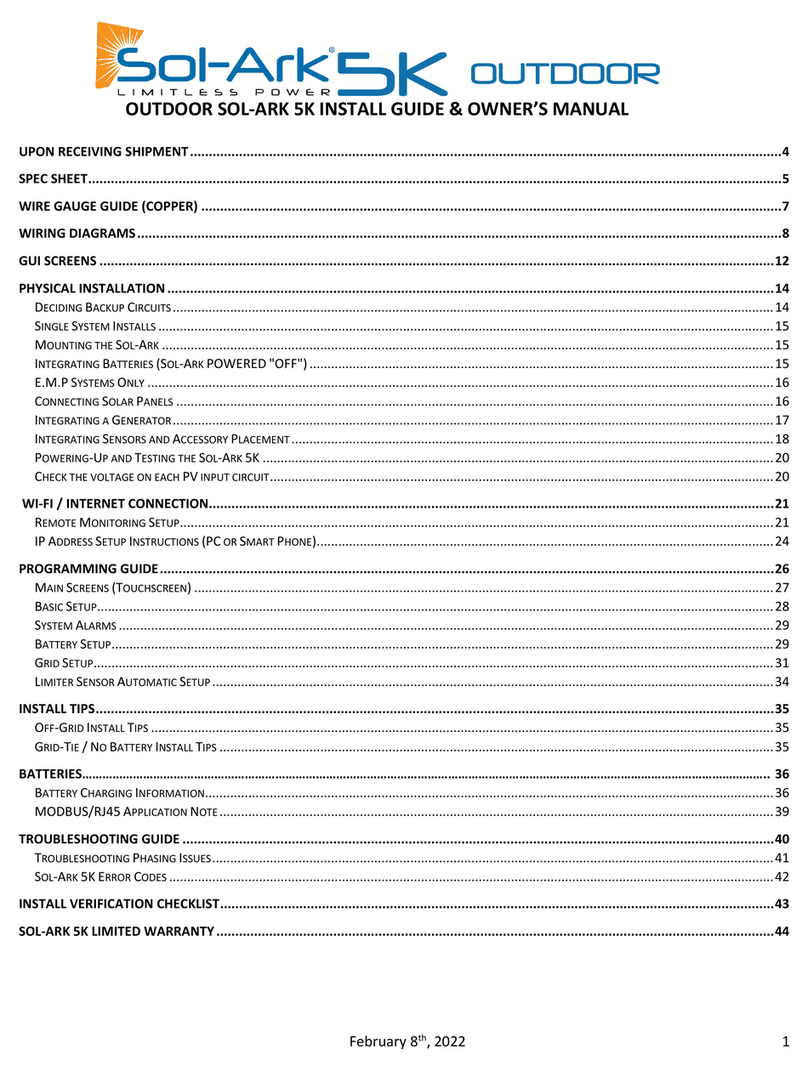
Solark
Solark 5K User manual
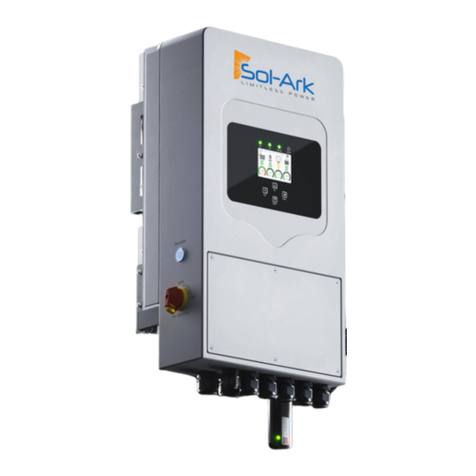
Solark
Solark 5K-IP-N Assembly instructions
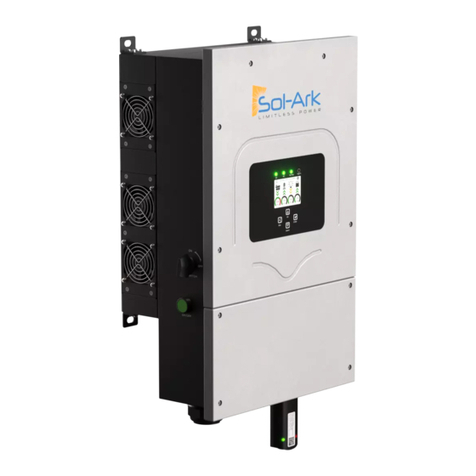
Solark
Solark 8K-2P-L User manual

Solark
Solark 8K User manual
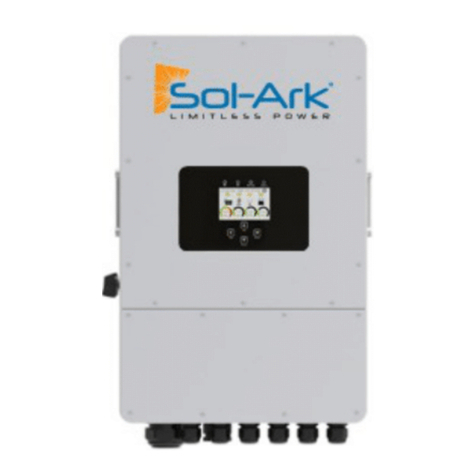
Solark
Solark L12K-Tr User manual
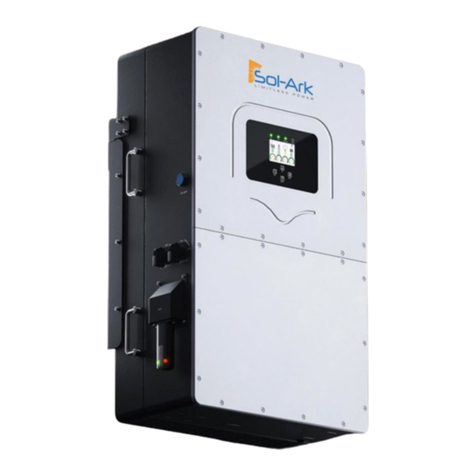
Solark
Solark 30K-3P-N User manual
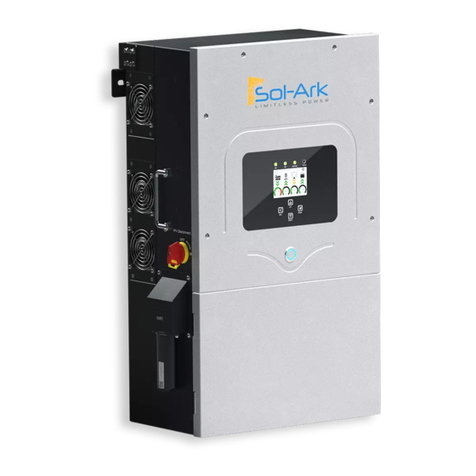
Solark
Solark L8K-2P User manual
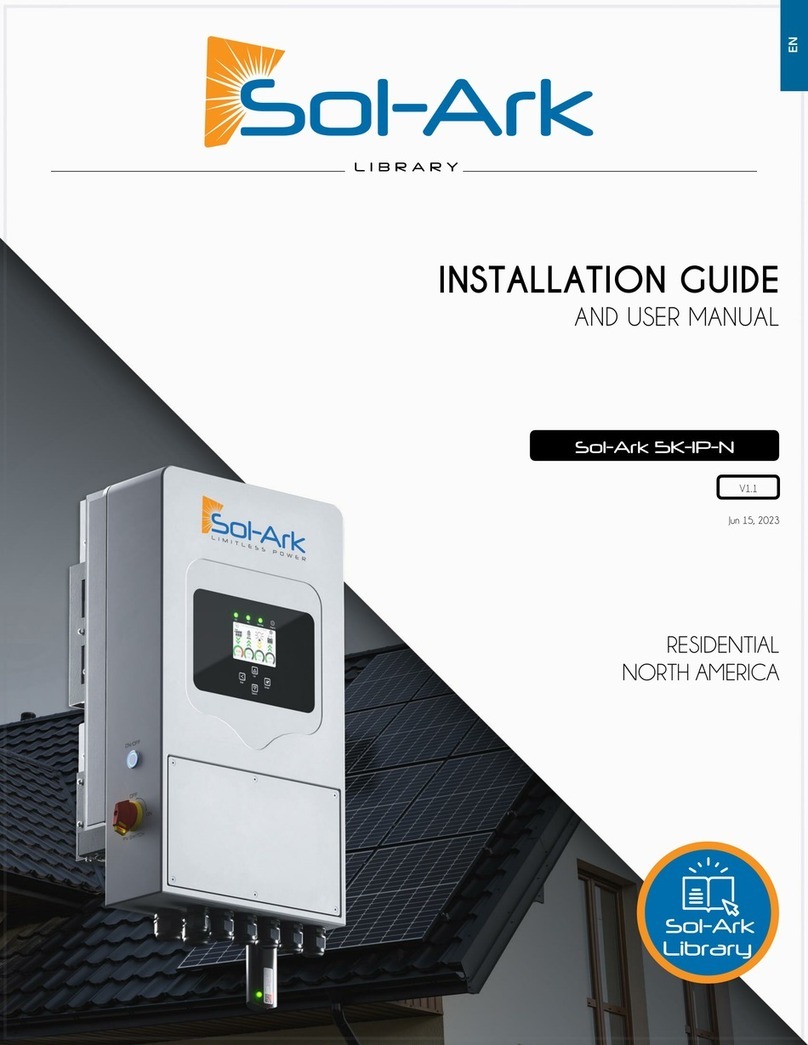
Solark
Solark SA-5K-1P Assembly instructions
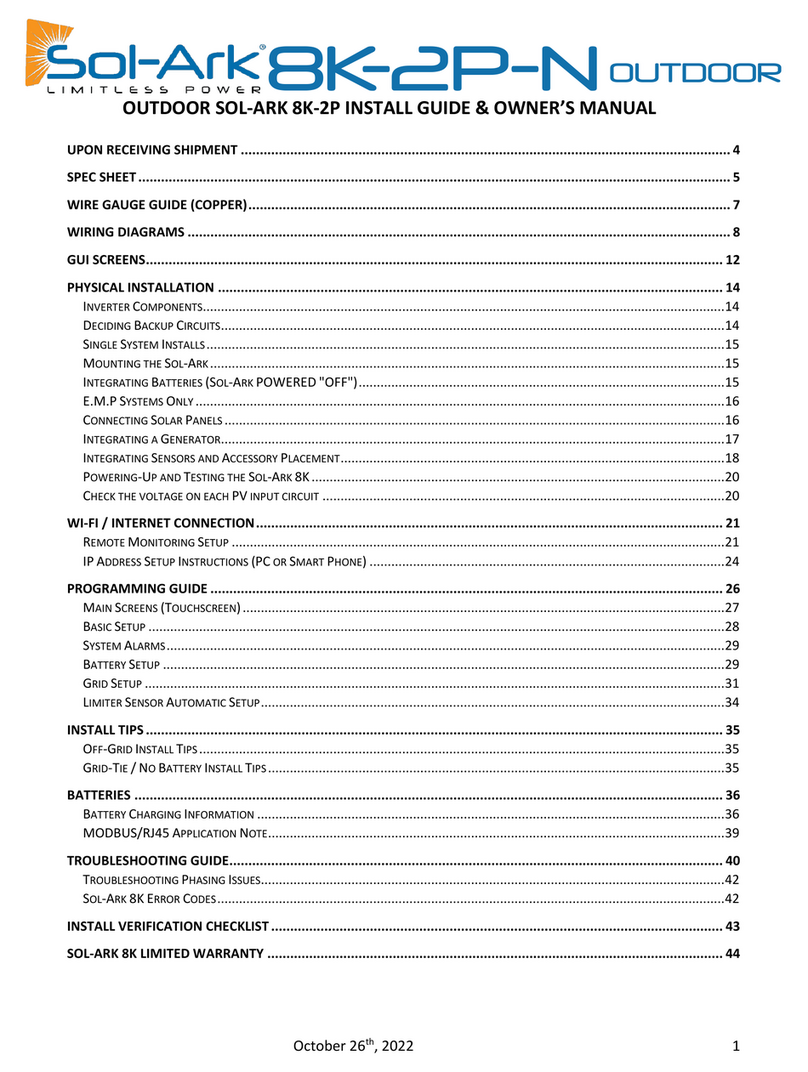
Solark
Solark 8K-2P-N User manual

Solark
Solark 8K User manual
